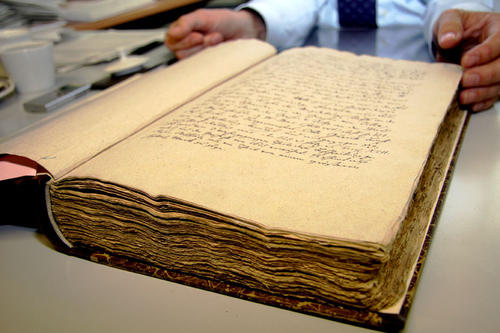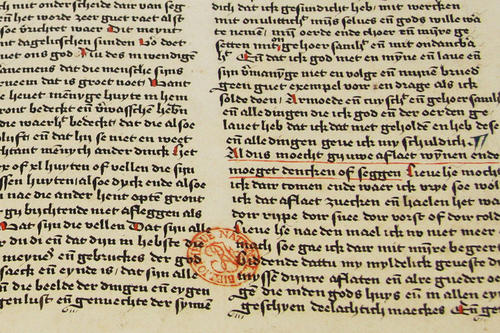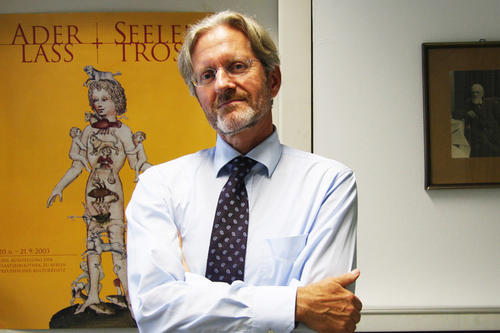History Is No Mystery
Deciphering old manuscripts is one of the areas of focus of the master’s degree program in Editorial Studies at Freie Universität Berlin.
Aug 31, 2011
Paleography is the study of ancient writing. Depicted here is a report on the destruction of Magdeburg in 1631.
Image Credit: Irina Sulejmanovic
This manuscript of sermons by the mystic Johannes Tauler was written in the mid-16th century in a convent in Arnhem (Netherlands).
Image Credit: Irina Sulejmanovic
Eef Overgaauw heads the manuscript division of the German State Library and teaches in the Editorial Studies degree program at Freie Universität.
Image Credit: Irina Sulejmanovic
The days of little hooks, curls, and loops are over – at least in Hamburg’s elementary schools, where cursive writing is being struck from the list of requirements in German classes. Computer and cell phone keyboards have largely replaced fountain pens, and those who can still decipher Grandma’s recipes are few indeed these days. Anyone who wants to read even older handwritten texts needs skills in paleography. The study of handwriting is taught at only a few higher education institutions in Germany – and Freie Universität is one of them.
Whenever Eef Overgaauw is about to leave his office at the German State Library in Berlin to hold seminars in Dahlem, his path takes him to the copier. As the head of the manuscript department, he is in charge of one of Europe’s most extensive collections. Chronicles, recipes, sermons, medieval astrological tracts, or even travel notes taken by Alexander von Humboldt: Most of the time, the valuable originals are kept hidden away in the library’s high-security collection, well protected from light, humidity, and temperature fluctuations.
Anyone who wants to read them needs skills in paleography – and that is just what Overgaauw teaches, as an adjunct professor, to students of Editorial Studies at Freie Universität. “And manuscript reading is one of the most important subjects in the program,” says Jörg Jungmayr, the coordinator of the master’s degree program.
Since the winter semester of 2003/04, about 15 students who have already earned a bachelor’s degree in a discipline associated with history, language, or literature are permitted to enroll each year and learn to edit texts. Knowledge of the various stages a manuscript passes through before publication are needed not only in academia, but also at publishing houses, archives, and libraries. Trained paleographers have become a rarity, since many universities have reduced the number of “small disciplines” they offer.
“Editing means making decisions,” says Overgaauw. Different versions of a text that have come down through history, written by different people, alternative pieces of text within a manuscript, rudimentary punctuation, or letter forms that are no longer used today force the editor to make his or her own determinations as early as when preparing the transcript or copy.
Not all of the details of a manuscript are relevant to today’s readers; in many cases, the reader is not even aware of the processes an older text has undergone before printing. Overgaauw aims to create an awareness of these factors among his students. The Dutch-born Overgaauw, who moved to Berlin in 1990 to do research and has headed the German State Library’s manuscript department for eleven years, teaches a required module in which students learn to read the Gothic scripts that were common in Germany from the 16th century to the late 19th century.
“We work with Gothic cursive script, a highly differentiated, interesting type of handwriting that was used for German works. It changed a great deal over time, so we can look at the characteristics of the writing for clues to the period when a text was written. At the time, there was another script used for Latin texts, called humanistic cursive, which is less differentiated and therefore not as interesting for our purposes,” Overgaauw says. Particularly difficult to decipher in general, he continues, are some capital letters, combinations of letters, and individual idiosyncrasies in a person’s handwriting, which were once more strikingly different than they are today.
In his seminar, the paleographer works with students on a broad spectrum of manuscripts and edited versions of the same texts, focusing especially on texts that are interesting from the standpoint of cultural history, but have remained largely unknown. “The students are generally curious, and if I were to use texts from well-known authors or figures such as Luther or Wallenstein, I would direct their attention too much to the person and less to the script,” he says.
Adjunct professor Overgaauw says learning to read an old script is like learning a foreign language. Even students from Greece or China – whose native language in turn has its own writing system – are successful in doing so.
“I myself spend most of my time at the library working on administrative tasks, so I am always happy to see former students sitting in the manuscript reading room, preparing edited versions for term papers or thesis projects,” Overgaauw says. After all, he knows that the collections of the German State Library hold many treasures that have never been edited – and some that have never even been read – just waiting to be discovered.
Further Information
Prof. Everardus Overgaauw, Adjunct Professor of Paleography and Codicology of the Middle Ages and the Early Modern Period, Email: Everardus.Overgaauw@sbb.spk-berlin.de



